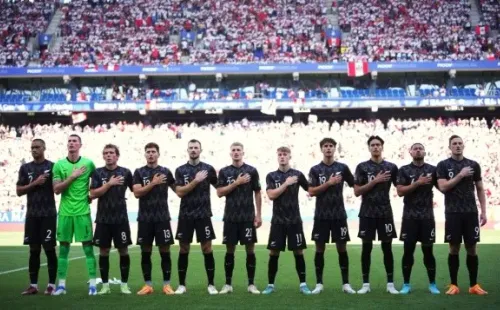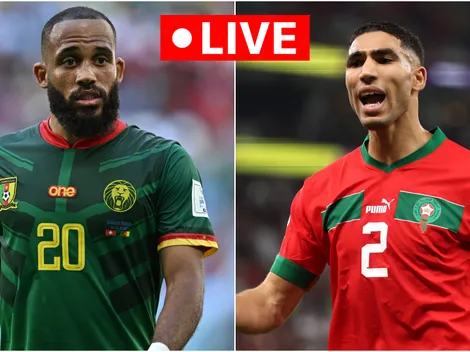You probably don’t recognize the name Norjmoogin Tsedenbal. Born in Mongolia on September 12, 1998, Tsedenbal is a defender who plays for Ulaanbaatar City, in the Mongolian National Premier League. Tsedenbal might not play in the most prestigious club or in the most prestigious league, but he will forever be remembered as being the first player to score in the Qualifiers for the 2022 FIFA World Cup.
The defender did so by converting a free kick against Brunei on June 6, 2019, thus signaling the first of many goals on the road to Qatar. Ever since, we have seen the exciting UEFA World Cup Qualifiers come to an end with Wales snatching a last-minute ticket to the most prestigious tournament in the world. We saw the Confederation of African Football (CAF) Qualifiers finish with a gut-wrenching faceoff between Sadio Mané and Mohamed Salah, and Iran, South Korea and Japan assert their dominance in the Asian Football Confederation (AFC) Qualifiers.
And don’t forget about Concacaf, where Canada finally returned to a World Cup after a 36-year absence, topping both regional powerhouses Mexico and the United States. The long, winding road that began with Tsedenbal’s goal against Brunei is nearly over, but there are still two crucial matches to be played. On June 13 and 14, in the Ahmad bin Ali Stadium, Australia will take on Peru and Costa Rica will take on New Zealand in a single-game decider for the final two spots in Qatar. Will the massive efforts all four countries have undertaken in the past few years have been for naught if they don’t qualify? How did nations that normally make the tournament find themselves in this position? Let’s find out.
Costa Rica
If you would’ve told anyone halfway through the Concacaf World Cup Qualifiers Final Round that Costa Rica would be playing in the intercontinental playoffs for a place in Qatar, you would most definitely have been laughed at. The date was November 12, 2021, and La Sele was facing the second to last game of the year in World Cup Qualifiers with only six points after the first six matches. Getting a single point out of their visit to Canada’s Commonwealth Stadium in Edmonton would be golden for manager Luis Fernando Suárez, but they faced one of the region’s toughest teams.
Despite a difficult start, Costa Rica settled into the game and seemed to head into the final 30 minutes with the possibility of upsetting the home side. That was until backup goalkeeper Leonel Moreira, in goal with Keylor Navas injured, made a mistake that granted Jonathan David a golden opportunity to score. The LOSC Lille man didn’t disappoint and took the chance to put the night’s only goal on the scoreboard.
The painful defeat away at Canada meant that, having played 7 out of the possible 14 games of Qualifiers, Costa Rica stood fifth out of eight sides, with a mere six points. Furthermore, the Central American team was seven points away from third-placed Canada and five points away from fourth-placed Panama. It seemed a near certainty that the nation that surprised the globe in 2014 would not be reprising their role in Qatar. In came Gerson Torres.
Tying Honduras 1-1 at home in the last matchday before the January window, the 90th minute struck and the referee added five minutes. In the last minute of added time, Joel Campbell sent a hopeful ball into the Honduran box. Johan Venegas headed towards Torres, who in turn sent the ball into the back of Buba Lopez’s goal. The Estadio Nacional erupted into unbridled joy, and Los Ticos finally saw the light after being in the darkness for much of World Cup qualifying.
Torres’s goal not only shook an entire nation, but it set into motion an impressive streak of positive results for Costa Rica. After the 2-1 win over Honduras, Costa Rica beat Panama 1-0 at home, tied Mexico 0-0 away, beat Jamaica 1-0 away, beat Canada 1-0 at home, beat El Salvador 2-1 away and defeated the United States 2-0 at home. This meant that La Sele finished even on points with the Stars and Stripes, losing out on direct World Cup qualification on goal difference.
Luis Fernando Suárez almost miraculously managed to recover a side that was practically eliminated halfway through the qualifying cycle, and turned them into a winning machine that revitalized the core parts of the historic 2014 Tico side, such as Bryan Ruíz, Keylor Navas and Celso Borges.
Prior to the hugely important game against New Zealand, Costa Rica fell 2-0 against Panama in the first matchday of the Concacaf Nations League. On the injury front, Ronald Matarrita and José Guillermo Ortíz won’t be available for team selection against the All Whites. Up next, a win or go home matchup.

Costa Rican players celebrate a goal by Celso Borges. (Victor Baldizon/Getty Images)
New Zealand
New Zealand’s road to the intercontinental playoffs has been vastly different than Costa Rica’s. Just to give you an idea of the difference in footballing level between the opponents in Concacaf and those in Oceania, here are the FIFA rankings (as of June 9, 2022) of the eight nations that qualified for the OFC Qualifiers Group Stage and those who played in the Concacaf Qualifiers Final Round.
OFC:
New Zealand (#101)
Solomon Islands (#137)
New Caledonia (#160)
Papua New Guinea (#162)
Tahiti (#164)
Fiji (#165)
Vanuatu (#166)
Cook Islands (#190)
Concacaf:
Mexico (#9)
United States (#15)
Costa Rica (#31)
Canada (#38)
Panama (#61)
Jamaica (#64)
El Salvador (#74)
Honduras (#82)
The numbers speak for themselves: every single nation that participated in the Concacaf Qualifiers Final Round is ranked higher than every team that played in the OFC Qualifiers Group Stage. New Zealand had no problem breezing past the first hurdle towards Qatar, obtaining nine points out of their three group games, ending with a +11 goal difference after conceding only once.
Curiously enough, the OFC Qualifiers Final Round and the Final Stage games were all played in Qatar. For the head-to-head elimination matches, New Zealand beat Tahiti 1-0 in the semifinals and took care of Solomon Islands in the final by thrashing them 5-0. This signified the second straight World Cup qualifying cycle in which the All Whites defeated Solomon Islands by a five goal difference in the final.
On the road to Russia, New Zealand lost in the intercontinental playoff against Peru by a 2-0 aggregate score. Now, they will take on Costa Rica with hopes of playing in their third-ever World Cup, with the most recent one being in 2010, when they famously tied 1-1 against Italy. To prepare for the crucial showdown, Danny Hay’s men played Peru and Oman in friendlies, with the squad relying mainly on Newcastle United’s Chris Wood to provide the main attacking threat.
The rest of the team includes several known names, such as Sydney FC’s Kosta Barbarouses, Melbourne Victory’s Marco Rojas, and former West Ham player Winston Reid. With the new intercontinental playoff format, where the home and away fixtures were replaced by one-off matches, New Zealand will avoid the possibility of painful home defeats such as the 2013 one against Mexico and the 2017 one against Peru. Whether they can take onand defeat an inspired Costa Rica side, is another task altogether.

New Zealand players sing the national anthem. (Alex Caparros/Getty Images)
Australia
Australia has attended every single World Cup since 2006, with varied results. In Germany, they lost in the Round of 16 to a very late and very controversial Franceso Totti penalty. In South Africa, Brazil and Russia, they finished third in their group. And now, they might not even play in the tournament at all. How did the Socceroos reach this point?
As a reminder, the team managed by Graham Arnold plays in the Asian Football Confederation instead of the Oceania Football Confederation because they requested a change in 2005 in order to increase their level of competitiveness.
Australia’s road to Qatar began in the Second Round of the AFC Qualifiers, where they topped Group B with a resounding 24 points in 8 matches, having scored 28 times and conceding only twice. The 12 teams that progressed to the Third Round were split into two groups of six, with the Socceroos sharing their sector with Saudi Arabia, Japan, Oman, China and Vietnam. There, they finished in a far third place, seven points away from second-placed Japan and eight points away from first-placed Saudi Arabia, both of whom qualified directly to the World Cup.
United Arab Emirates (UAE) also finished third in their group, with three points less than Australia’s 15, which meant that both countries had to face each other in a direct elimination match to determine who would then progress to the intercontinental playoff. The high stakes game took place on June 7, 2022, in a packed Al Rayyan Stadium in Qatar.
The first 45 minutes produced no goals, but the second half was full of emotions. In the 53rd minute, Australia’s Martin Boyle ran down the right hand side and crossed back to Jackson Irvine. The FC St. Pauli man then slotted the ball into the back of the net with composure, to put the Socceroos within less than 40 minutes of the intercontinental playoff. But, a mere four minutes later, the UAE tied the match.
Harib Al-Maazmi provided a large cross into the box, and in an unfortunate turn of events, the ball bounced off Irvine himself and then into Caio Canedos’ feet. The Brazilian-born attacker didn’t think twice and put the Western Asian nation level. When it seemed like the game would go into extra time, what could be a historic moment for Australia took place.
In the 84th minute, a corner kick rebound fell into Adjin Hrustic, who was barely outside of the opposing box. The Eintracht Frankfurt midfielder violently impacted the ball, which hit UAE defender Ali Salmeen and then went into the goal for a dramatic ending and a 2-1 win for Australia. Now, they will face Peru on June 13 for a spot in the same tournament where both nations played each other in 2018.
Back then, La Blanquirroja took home the spoils with a 2-0 victory, courtesy of André Carrillo and Paolo Guerrero’s goals. Funnily enough, current Socceroo manager Graham Arnold was in the stands while dutchman Bert Van Marwijk was in the dugout. Now, it’s Arnold’s turn to put Australia back in a World Cup, but their opposition will be anything but simple.

Ajdin Hrustic of Australia celebrates after their sides victory during the 2022 FIFA World Cup Playoff match against United Arab Emirates. (Mohamed Farag/Getty Images)
Peru
The final of the four teams featuring in the intercontinental playoffs is Peru, who are looking to play in their sixth World Cup in history, and the second consecutive one. Saying La Blanquirroja had a difficult qualifying cycle in Conmebol is an understatement. Everything started in October 2020, with a 2-2 tie away against Paraguay. The positive result would end up being Peru’s only point in the first five matches, due to defeats against Brazil, Chile, Argentina and Bolivia.
A home win against Venezuela seemed to signal Ricardo Gareca’s team starting to change their mindset and the way they played, with Gianluca Lapadula leading the Inca’s front line. However, a 3-0 defeat at home against Colombia sent shockwaves through the Peruvian camp, with World Cup qualification being not much more than a dream at the time. Then came a visit to Quito, to face Ecuador.
The day was June 8, 2021. Lapadula provided assists to Christian Cueva and Luis Advíncula, whose goals signified Peru’s first away win in Conmebol’s Qualifiers. However, a tie against Uruguay, and another defeat against Brazil left La Blanquirroja in a precarious position: with ten games played, they were in seventh place with a mere eight points, five away from the intercontinental playoffs.
Peru’s inconsistent form led them into the final two matches notknowing whether they would be in Qatar, whether they would play the Repechaje or whether they would be eliminated altogether. Even so, when they faced Uruguay in March, 2022 at the Estadio Centenario, the possibility of making the World Cup directly was still present. Peru entered the match fifth in the standings, one point away from the Charrúas.
The third best away side in Conmebol, led by Gareca, needed an away win to stamp their ticket to a second consecutive World Cup. In spite of trailing in the first half due to a Giorgian De Arrascaeta goal, the Inca squad managed to fight back and seemed to have an equalizer in the second half. Miguel Trauco crossed the ball in from the left hand side, and goalkeeper Sergio Rochet seemed to take hold of the ball once it had already crossed the goal line.
A lengthy VAR review, with multiple camera angles, wasn’t enough to overturn the no goal decision. Since Conmebol doesn’t use goal-line technology, the only resources available to judge whether a ball crossed the goal line or not are broadcast footage replayed by VAR and referee opinion. Peru didn’t get the decision in their favor and couldn’t score throughout the rest of the match, allowing Uruguay to punch their ticket to Qatar that same night.
Gareca’s men reached the final matchday fifth, with 21 points, with Colombia and Chile one and two points behind, respectively. That meant that only a win would secure a World Cup spot for Peru, regardless of other results. Said win happened against Paraguay, courtesy of Gianluca Lapadula and Yoshimar Yotún goals, to take the three points with a 2-0 result. Now, the South American side faces a tricky and inspired Australia, with what the Peruvian press have speculated will be the following starting eleven:
Pedro Gallese; Luis Advíncula, Carlos Zambrano, Alexander Callens, Miguel Trauco; Renato Tapia, Sergio Peña, Yoshimar Yotún;André Carrillo, Christian Cueva, Gianluca Lapadula

Gianluca Lapadula of Peru celebrates after scoring a goal. (Alex Caparros/Getty Images)





